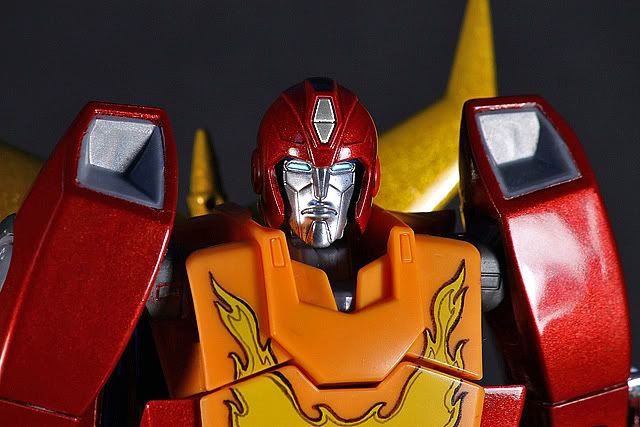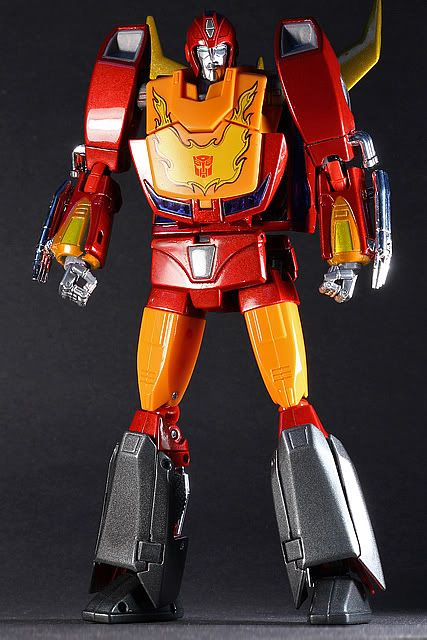|
|
Post by chachipower on Sept 5, 2011 17:44:54 GMT -5
I figured, what the heck, it's only an expensive Transformer, what can go wrong?    Matrix  There's more pictures on my blog www.rocketpuncharmy.com |
|
|
|
Post by Cyrano on Sept 5, 2011 18:12:53 GMT -5
That's some nice work, there  What did you use as a topcoat to get that great glossy car finish? |
|
|
|
Post by chachipower on Sept 5, 2011 19:03:45 GMT -5
That's some nice work, there  What did you use as a topcoat to get that great glossy car finish? Thanks!, I used good ol fashioned Automotive clearcloat, some 600-2000 grit sandpaper to smooth out the orange-peel and then some polishing compound with a bit of elbow grease  My hands ache lol |
|
|
|
Post by magengar on Sept 6, 2011 12:53:42 GMT -5
Awesome paint job, bro, it looks even better now than it did back in its former paint job.  zozo-mag |
|
|
|
Post by mojacko on Sept 6, 2011 14:49:15 GMT -5
wicked work man....nice paint apps did you disassemble all the parts first for RODI??? was it hard putting it back??
|
|
|
|
Post by admin1 aka Ed on Sept 6, 2011 21:36:03 GMT -5
Thumbs up! I don't see one spec of dust...you must have a semi-pro based paint booth.
Great detailing and it looks perfect, Perfect!
|
|
|
|
Post by chachipower on Sept 8, 2011 1:04:55 GMT -5
Thanks guys! Thumbs up! I don't see one spec of dust...you must have a semi-pro based paint booth. Great detailing and it looks perfect, Perfect! I'll be honest, I did it in a plain ol dusty basement. The trick is to use automotive paint so it dries quick before dust settles on it. If it does, it can be wet-sanded/buffed off just as you would on a real car. wicked work man....nice paint apps did you disassemble all the parts first for RODI??? was it hard putting it back?? I sure did disassemble it! check out rocketpuncharmy.blogspot.com/2011/09/project-rodimus-second-stab-at.html for more details and pics of disassembly. Ill update more soon. |
|
|
|
Post by mojacko on Sept 8, 2011 6:24:42 GMT -5
i've always been wondering how to do this wet sanding technique....maybe you can post some techniques here.....thanks mate ;D
i did check out your blog....great blog!!! ;D
|
|
|
|
Post by chachipower on Sept 9, 2011 12:04:51 GMT -5
i've always been wondering how to do this wet sanding technique....maybe you can post some techniques here.....thanks mate ;D i did check out your blog....great blog!!! ;D Thanks, Ill put something up someday. Stuck in bed with a pinched nerve on my back so I cant really move  |
|
|
|
Post by magengar on Sept 9, 2011 15:22:09 GMT -5
For wet-sanding, I've always used very very fine sandpaper and some water.
Gives me an almost shiny luster while removing all the loose dirt so my work
stays clean. I haven't done enough wet-sanding to develop my own technique.
You're better off learning how Chachipower does his wet-sanding so
you don't go wrong.
zozo-mag
|
|
|
|
Post by chachipower on Sept 9, 2011 23:17:57 GMT -5
For wet-sanding, I've always used very very fine sandpaper and some water. Gives me an almost shiny luster while removing all the loose dirt so my work stays clean. I haven't done enough wet-sanding to develop my own technique. You're better off learning how Chachipower does his wet-sanding so you don't go wrong. zozo-mag I know this should be posted somewhere else, and I will sometime but, Wet sanding basically gets rid of orange-peel which means waviness in paint. It also gets rid of dust particles. -First I primer the figure after lightly sanding with 600 grit -Then wash the parts in soap and air dry -mist primer on, then when dry, coat with primer - if primer has imperfections, sand with fine 600 sandpaper under running water being careful not to eat through, you can use higher fine grit too. - Apply base coat. Mist first, then apply first coat. Sometimes this will be enough to provide gloss coat but almost always imperfections and offers no protection against chipping. 2-3 light coats should be sufficient - you can also wet sand the base coat if there are imperfections, but if they are teeny, you can leave em. this would be a good time to apply panel lines (make sure the paint used for panel lines does not react with paint used. Ive used Gundam markers and Laquer paint eats at it if applied heavy. - Finally mist the clear coat ESPECIALLY if you have Gundam marker panel lines, then after the mist coat dries, apply 2-3 coats, not too heavy, just enough for it to spread into a nice gloss. The more coats the better, just no heavy or you will cover panel lines. Usually this will give you a VERY wet look, almost too wet, will look a bit cheap really - take 2000 grit and gently sand under running water then dry off and look at surface, you will see glossy bits and dull bits. If the there are glossy bits, thats recessed areas, may want to leave those as sanding more to level will remove to much paint. ( this is stuff you may want to take care of during primer) -Once you have a silky smooth feel on paint after sanding with 2000+ grit under running water, you can grab polishing compound and buff away. then keep going til you get a good shine. Tips: -always press sprayer before sweeping past part. Never start sprayer on top of part, even if you are trying to reach a hard to rech spot. and dont let go of sprayer until you sweep past entire part. This technique has only been done on Automotive Lacquer based paints. Any good automotive touch up spray will work. Why Lacquer and not enamel? Lacquer dries really fast, so you dont have to wait forever like enamel. Also Auto paints also come in little touch up bottles so you can repair chips easily  Lots of work but worth it. - |
|
|
|
Post by TheMazingerZ on Sept 9, 2011 23:25:25 GMT -5
Excellent post there chachipower! Will definitely save those instructions! ;D
}D
|
|
|
|
Post by magengar on Sept 10, 2011 0:17:08 GMT -5
Ditto the same here. I'll practice those steps next time
on my resin parts and custom paint-jobs.
zozo-mag
|
|
|
|
Post by mojacko on Sept 11, 2011 12:02:57 GMT -5
well said chachi....and thanks for sharing!!!
|
|